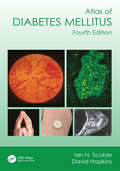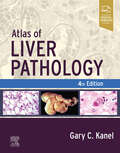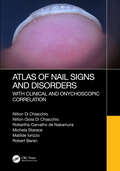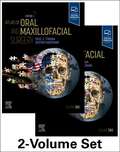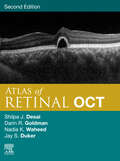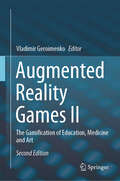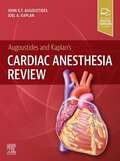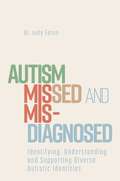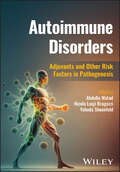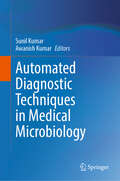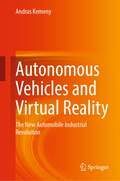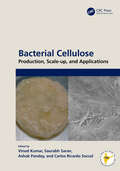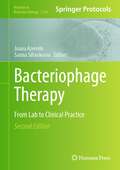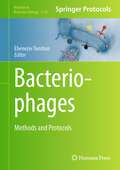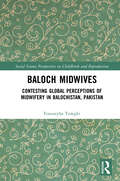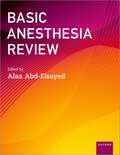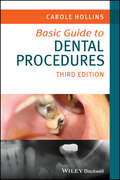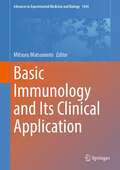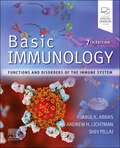- Table View
- List View
Atlas of Diabetes Mellitus
by Ian N. Scobie David HopkinsThis completely revised and updated Fourth Edition of the Atlas of Diabetes Mellitus provides a broad coverage of all aspects of diabetes mellitus and an extensive collection of common and rare clinical images. It aims to provide an invaluable resource for anyone interested in the management of this ubiquitous clinical condition including primary care/ family physicians, endocrinologists, physicians in training, diabetic specialist nurses and other key professionals who are likely to be involved in the care of patients with diabetes mellitus.
Atlas of Diabetes Mellitus
by Ian N. Scobie David HopkinsThis completely revised and updated Fourth Edition of the Atlas of Diabetes Mellitus provides a broad coverage of all aspects of diabetes mellitus and an extensive collection of common and rare clinical images. It aims to provide an invaluable resource for anyone interested in the management of this ubiquitous clinical condition including primary care/ family physicians, endocrinologists, physicians in training, diabetic specialist nurses and other key professionals who are likely to be involved in the care of patients with diabetes mellitus.
Atlas of Liver Pathology - E-Book: Expert Consult - Online And Print (Atlas of Surgical Pathology)
by Gary C. KanelHighly illustrated and conveniently templated for quick reference, Atlas of Liver Pathology, 4th Edition, is a useful Atlas and text for every practicing pathologist or trainee who assesses liver biopsy specimens. From cover to cover, it contains all the information needed to identify histologic features and correlate them with clinical findings, offering a clearer understanding of the clinical implications of the disease as it relates to treatment. More than 1,200 high-quality, full-color images and illustrations provide you with a complete visual guide to the vast majority of liver diseases and assist in the diagnoses of biopsy and resected liver specimens. Provides clear, templated information for each disease: Major Morphologic Features; Special Stains; Differential Diagnoses; Clinical and Biologic Behavior; and Treatment and Prognosis. Incorporates relevant data from ancillary techniques (immunohistochemistry, cytology, cytogenetics and molecular genetics), giving you the necessary tools required to master the latest breakthroughs in diagnostic technology. Incorporates the latest diagnostic biomarkers and their utility in differential diagnoses, newly described variants, and new histologic entities. Contains two new chapters on liver biopsy interpretation and autoimmune hepatitis. Features concise, bulleted text and abundant tables that cover common as well as rare diseases, differential diagnoses, and more.
Atlas of Nail Signs and Disorders with Clinical and Onychoscopic Correlation
by Nilton Di Chiacchio Nilton Gioia Di Chiacchio Robertha Carvalho de Nakamura Michela Starace Matilde Iorizzo Robert BaranThis atlas allows dermatologists and resident and qualified professionals in other disciplines to reach a quick diagnosis, with a wealth of clinical and dermatoscopic images for convenience.Key features: Provides a quick and straightforward guide to diagnosis for medical professionals. Allows residents and professionals in other disciplines easy access to the essential points. Presents the expertise of some of the most eminent international nail specialists.
Atlas of Nail Signs and Disorders with Clinical and Onychoscopic Correlation
by Nilton Di Chiacchio Nilton Gioia Di Chiacchio Robertha Carvalho de Nakamura Michela Starace Matilde Iorizzo Robert BaranThis atlas allows dermatologists and resident and qualified professionals in other disciplines to reach a quick diagnosis, with a wealth of clinical and dermatoscopic images for convenience.Key features: Provides a quick and straightforward guide to diagnosis for medical professionals. Allows residents and professionals in other disciplines easy access to the essential points. Presents the expertise of some of the most eminent international nail specialists.
Atlas of Oral and Maxillofacial Surgery: Atlas of Oral and Maxillofacial Surgery - E-Book
by Paul Tiwana Deepak KademaniEnhance your surgical skills with Atlas of Oral and Maxillofacial Surgery, 2nd Edition! Written by respected international contributors and edited by OMS experts Paul Tiwana and Deepak Kademani, the new edition of this practical, comprehensive guide is divided into two volumes with eBook access included with the print purchase. It offers detailed, step-by-step instructions and more than 2,500 full-color illustrations that demonstrate how to plan for and perform oral and maxillofacial surgical procedures safely and efficiently. Comprehensive and expanded coverage addresses the broad scope of the specialty, ranging from the surgical anatomy of the head and neck to oral surgery, implant surgery, orthognathic and craniofacial surgery, cleft lip and palate, craniomaxillofacial trauma, head and neck oncology, reconstructive procedures, TMJ surgery, facial cosmetic surgery, obstructive sleep apnea, and more. Comprehensive, consistent approach to OMS operative procedures offers practical guidance for the management of patients with oral and maxillofacial disorders, with each surgical procedure chapter approximately six to eight pages in length and covering the following topics: armamentarium, history of the procedure, indications for use of the procedure, limitations and contraindications, technique, alternate or modified technique, avoidance and management of intraoperative complications, and postoperative considerations. More than 2,500 images include vibrant, modern medical illustrations and clinical photos that make up the heart of each surgical chapter and bring it to life visually. Detailed, step-by-step approach shows how to perform OMS surgical procedures safely and efficiently. Coverage of alternative and modified techniques addresses options beyond the standard techniques. Expert, international contributors provide authoritative guidance on the OMS procedures they typically perform. NEW! Two-volume extended edition is easier to navigate and includes extensive updates throughout. NEW! More than 30 new chapters expand the coverage of implants, craniofacial surgery, and facial cosmetic surgery — plus an all-new section discusses obstructive sleep apnea (OSA). NEW! An eBook version included only with print purchase allows you to access all the text, figures, and references, with the ability to search, customize your content, make notes and highlights, and have content read aloud.
Atlas of Retinal OCT E-Book: Optical Coherence Tomography
by Shilpa J. Desai Darin R. Goldman Nadia K. Waheed, MD, MPH Jay S. DukerUnparalleled for aiding diagnosis of retinal disease and recording disease progression, Optical Coherence Tomography (OCT) remains one of the most significant advances in ophthalmology over the past 50 years. Atlas of Retinal OCT, 2nd Edition, provides expert guidance in making the most of this diagnostic tool with high-quality, oversized images that show precise detail and assist with rapid, accurate clinical decision making. Led by the same expert team of Drs. Jay S. Duker, Nadia K. Waheed, and Darin R. Goldman, and with the addition of new editor Dr. Shilpa J. Desai, this atlas remains your “go to" reference source for OCT imaging of the retina. Now updated throughout to align with current practice, it covers a range of both common and rare disorders and presentations. Features more than 1,000 high-quality illustrations depicting the full spectrum of retinal diseases using OCT and OCTA scans, supported by clinical photos and ancillary imaging technologies. Contains new and updated image examples throughout—including new OCTA images with artifacts and key findings highlighted. Presents images as large as possible on the page with an abundance of arrows, pointers, and labels to guide you in pattern recognition and eliminate any uncertainty. Includes the latest high-resolution spectral domain OCT technology and new insights into OCT angiography technology to ensure you have the most up-to-date and highest quality examples available. Provides key feature points for each disorder, giving you the need-to-know OCT essentials for quick comprehension and rapid reference. An excellent diagnostic companion to Handbook of Retinal OCT: Optical Coherence Tomography, 2nd Edition.
Augmented Reality Games II: The Gamification of Education, Medicine and Art
by Vladimir GeroimenkoThis is the second edition of the first ever research monograph that explores the exciting field of augmented reality games and their enabling technologies. The new edition has been thoroughly revised and updated, with 6 new chapters included. As well as investigating augmented reality games in education, the book covers the gamification of medicine, healthcare, and art. It has been written by a team of 43 researchers, practitioners, and artists from 12 countries, pioneering in developing and researching the new type of computer games.This book deals with a systematic analysis of educational augmented reality games, the gamification of elementary and secondary education, teachers’ novel key skills and new teaching methods in the classroom, creating immersive and playful reading experiences, augmented reality games for health promotion in old age and for transforming dental and physical education and practice, the gamification of augmented reality art, pervasive games, and gaming in public spaces, among other topics.Intended as a starting point for exploring this new fascinating area of research and game development, it will be essential reading not only for researchers, practitioners, game developers, and artists, but also for students (graduates and undergraduates) and all those interested in the rapidly developing area of augmented reality games.
Augoustides and Kaplan's Cardiac Anesthesia Review - E-BOOK
by John G.T. Augoustides Joel A. KaplanTurn to the trusted team of Drs. Joel A. Kaplan and John G.T. Augoustides for focused, comprehensive guidance on topics relevant to certification examinations for adult cardiac anesthesiology practitioners. Written by current leaders in the field, Augoustides and Kaplan's Cardiac Anesthesia Review summarizes critical, must-know cardiac anesthesia knowledge in a concise, quick-review format—making this an indispensable review tool for cardiac anesthesiologists and fellows, as well as advanced residents seeking a cardiac fellowship. Presents high-yield, bulleted outline summaries of key content to study along with multiple choice questions, answers, and rationales to solidify your understanding. Covers key topics such as preoperative assessment and management, including cardiovascular imaging; cardiovascular physiology and pharmacology; cardiovascular, neurologic, and coagulation monitoring; anesthetic considerations for specific cardiac procedures and conditions; cardiopulmonary bypass and extracorporeal membrane oxygenation; coagulation and transfusion; and postoperative management. Corresponds chapter by chapter to relevant content published in Kaplan’s Cardiac Anesthesia to help you make the most of your study time and learn more efficiently. Features high-quality illustrations, clinical photographs, charts, and graphs throughout to provide a visual aid to reinforce key information. Contains page number references to Kaplan’s Cardiac Anesthesia and the Journal of Cardiothoracic and Vascular Anesthesia (JCVA) in each rationale for further study.
Autism Missed and Misdiagnosed: Identifying, Understanding and Supporting Diverse Autistic Identities
by Judy EatonAutism presents in a multitude of different and highly nuanced ways - particularly as it intersects with variance in class, gender, race and age. Misunderstanding and misinformation around variant and differing presentations means that misdiagnosed individuals and those who do not receive a diagnosis at all are often failed by medical, education, social care and criminal justice systems. They are detained in inappropriate settings; don't receive beneficial therapeutic input; have their families accused of fabricated or induced illness (FII); are kept in prison or youth offending institutions longer than their original tariffs, and shockingly their life expectancy is often curtailed as a result. This comprehensive resource will help multidisciplinary professions to understand, contextualise, and better identify diverse autistic presentations. It includes an overview of the autism diagnostic process, an exploration of controversial and commonly confused diagnoses such as PDA, ODD, CD, ASPD, and BPD; discussions of best practice for investigating FII; and analysis of the specific challenges of autism diagnosis in relation to women and girls, BAME communities, schools, and the criminal justice system.
Autoimmune Disorders: Adjuvants and Other Risk Factors in Pathogenesis
by Abdulla Watad Nicola Luigi Bragazzi Yehuda ShoenfeldAutoimmune Disorders Comprehensive resource on the science of autoimmune disorders, covering causes, treatment, prevention, and the latest research in the field Autoimmune Disorders is an authoritative reference on the science of autoimmune disorders, covering their causes, including infections, vaccine adjuvants, environmental stimuli, and silicone implants, the latest research on the genetics, epigenetics, and immunology of autoimmunity, predictive markers, therapeutic approaches for treatment and prevention, and suggestions for future research directions. This book explores the intricate connections between adjuvants and autoimmune responses, focusing on the emergence of the Autoimmune/Inflammatory Syndrome Induced by Adjuvants (ASIA syndrome), as well as autoimmune connections in areas such as chronic fatigue syndrome, autoantibodies targeting the autonomic system, and small fiber neuropathy. The authors emphasize the profound impact of vaccines on public health, underscoring that their benefits far outweigh potential side effects and exploring the historical context of adjuvants in vaccine development. From tattoos to environmental factors, each chapter adds a unique thread to the tapestry of adjuvants, autoimmune responses, and their interactions. Sample topics covered in Autoimmune Disorders include: Food additives and dental implants as a trigger of autoimmunity and increased risk of ASIA syndrome as a result of the chemical and social factors Sustained immune activation in ASIA syndrome as a bridge to lymphomagenesis and how immune checkpoints, metals, and bisphenol connect to autoimmunity Postural Orthostatic Tachycardia syndrome (POTS), Sick Building syndrome, and Gulf War syndrome (GWS) as parts of ASIA syndrome Sarcoidosis and Sjögren’s syndrome as a proof of concept of hyperstimulation syndrome Autoimmune Disorders is an essential reference on the subject for academics, specialized postgraduate students, and practicing professionals seeking to improve integrated research strategies and foster a deeper understanding of the complex relationship between immunology, public health, and individual well-being.
Autoimmune Disorders: Adjuvants and Other Risk Factors in Pathogenesis
by Abdulla Watad Nicola Luigi Bragazzi Yehuda ShoenfeldAutoimmune Disorders Comprehensive resource on the science of autoimmune disorders, covering causes, treatment, prevention, and the latest research in the field Autoimmune Disorders is an authoritative reference on the science of autoimmune disorders, covering their causes, including infections, vaccine adjuvants, environmental stimuli, and silicone implants, the latest research on the genetics, epigenetics, and immunology of autoimmunity, predictive markers, therapeutic approaches for treatment and prevention, and suggestions for future research directions. This book explores the intricate connections between adjuvants and autoimmune responses, focusing on the emergence of the Autoimmune/Inflammatory Syndrome Induced by Adjuvants (ASIA syndrome), as well as autoimmune connections in areas such as chronic fatigue syndrome, autoantibodies targeting the autonomic system, and small fiber neuropathy. The authors emphasize the profound impact of vaccines on public health, underscoring that their benefits far outweigh potential side effects and exploring the historical context of adjuvants in vaccine development. From tattoos to environmental factors, each chapter adds a unique thread to the tapestry of adjuvants, autoimmune responses, and their interactions. Sample topics covered in Autoimmune Disorders include: Food additives and dental implants as a trigger of autoimmunity and increased risk of ASIA syndrome as a result of the chemical and social factors Sustained immune activation in ASIA syndrome as a bridge to lymphomagenesis and how immune checkpoints, metals, and bisphenol connect to autoimmunity Postural Orthostatic Tachycardia syndrome (POTS), Sick Building syndrome, and Gulf War syndrome (GWS) as parts of ASIA syndrome Sarcoidosis and Sjögren’s syndrome as a proof of concept of hyperstimulation syndrome Autoimmune Disorders is an essential reference on the subject for academics, specialized postgraduate students, and practicing professionals seeking to improve integrated research strategies and foster a deeper understanding of the complex relationship between immunology, public health, and individual well-being.
Automated Diagnostic Techniques in Medical Microbiology
by Sunil Kumar Awanish KumarThis book will explore the knowledge of current diagnostic automation techniques applied in the field of clinical microbiology, tropical diseases, POCT, etc. There is no such type of book related to this topic. This book will help clinicians, microbiologists, and researchers to make diagnostic algorithms for infectious diseases and help them in early diagnosis. Automation in clinical microbiology has revolutionized routine practice in diagnostic cum research in medical microbiology. This book covers the recent updates and advances in diagnostic microbiology and provides new techniques related to Genomic, Proteomic, and metabolomics in microbiology. This book will intensely discuss the new and innovative automation techniques available for diagnosis in the microbiology laboratory. This book is more focused on automation techniques, which are used in the early detection of infectious diseases even caused by rare microorganisms. Furthermore, this book has complied with the chapters that provide insights to readers with comprehensive and usable knowledge on automation techniques in diagnostic microbiology.
Autonomous Vehicles and Virtual Reality: The New Automobile Industrial Revolution
by Andras KemenyThis book concisely describes the technologies, human perception, and cognition issues relevant to autonomous vehicles. It also gives an insight in the changes bring about our future everyday lives.Autonomous vehicles are the future of the automobile industry. Automated driving (AD), also called self-driving, raises however several multiple questions, among them those of user safety and acceptation. Comprehensive HMI system design, with windshield display technics, will be necessary to deal with driving task delegations, bringing the use of VR or augmented reality (AR) technologies. In addition, the use of VR for all the vehicle interiors will progressively be proposed for entertainment, online business activities and for modified visual motion perception to alleviate car sickness, a form of motion sickness. Indeed, car sickness is already well known for many passengers, especially when reading or operating smartphones or other display devices. It is called to increase significantly with the introduction of autonomous vehicles where all users will be for long periods in various sitting positions. These two new trends, AD and VR, are already modifying our relationship with the world and the society. All together, they will change our way of life forever. The book will be of interest to professionals in the auto industry, researchers in automotive engineering and computer science and all those interested in the future of transport.
Bacterial Cellulose: Production, Scale-up, and Applications
by Vinod Kumar Saurabh Saran Ashok Pandey Carlos Ricardo SoccolThis reference book provides updated information on the production and industrial significance of bacterial cellulose. Bacterial cellulose is a natural fiber produced by certain microbes, mainly bacteria which belong to the Acetobacter genera. The book discusses its applications in different industrial sectors, such as food, pharmaceutical, energy, and wastewater treatment. It covers the production of cellulose from conventional and renewable feedstock and includes topics such as downstream processing, characterization, and chemical modification of bacterial cellulose. FEATURES Addresses the challenges of the production technologies of bacterial cellulose up to pilot scale Discusses cost-effective green processes using agri-processing residues and medium formulation Includes efficient preparation of nanocomposites using in vitro and in vivo methods Provides the latest applications of bacterial cellulose in the food and pharmaceuticals fields Reviews the production of bacterial cellulose from conventional feedstock such as sugars and starches This book is designed for industry experts and researchers of applied microbiology, bioprocesses, and industrial microbiology.
Bacterial Cellulose: Production, Scale-up, and Applications
by Vinod Kumar Saurabh Saran Ashok Pandey Carlos Ricardo SoccolThis reference book provides updated information on the production and industrial significance of bacterial cellulose. Bacterial cellulose is a natural fiber produced by certain microbes, mainly bacteria which belong to the Acetobacter genera. The book discusses its applications in different industrial sectors, such as food, pharmaceutical, energy, and wastewater treatment. It covers the production of cellulose from conventional and renewable feedstock and includes topics such as downstream processing, characterization, and chemical modification of bacterial cellulose. FEATURES Addresses the challenges of the production technologies of bacterial cellulose up to pilot scale Discusses cost-effective green processes using agri-processing residues and medium formulation Includes efficient preparation of nanocomposites using in vitro and in vivo methods Provides the latest applications of bacterial cellulose in the food and pharmaceuticals fields Reviews the production of bacterial cellulose from conventional feedstock such as sugars and starches This book is designed for industry experts and researchers of applied microbiology, bioprocesses, and industrial microbiology.
Bacteriophage Therapy: From Lab to Clinical Practice (Methods in Molecular Biology #2734)
by Joana Azeredo Sanna SillankorvaThis highly anticipated second edition details cutting-edge experimental approaches for bacteriophage research. This comprehensive volume details new and updated experimental approaches for isolating, formulating, and engineering bacteriophage medicinal products. Authored by leading experts and written in the highly successful Methods in Molecular Biology series format, each chapter includes introductions to their respective topics, lists of the necessary materials and reagents, step-by-step reproducible laboratory protocols, and valuable tips for troubleshooting and avoiding known pitfalls. Whether you are a seasoned scientist or a newcomer, Bacteriophage Therapy: From Lab to Clinical Practice, Second Edition provides essential tools and knowledge to advance bacteriophage research and its translation into innovative medicinal products and clinical therapies.
Bacteriophages: Methods and Protocols (Methods in Molecular Biology #2738)
by Ebenezer TumbanThis volume provides detailed protocols for the isolation, enumeration, characterization of diverse bacteriophages, including both small and jumbo bacteriophages, from soil, fecal, municipal wastewater, and from food niche samples. Chapters highlight the diversity of bacteriophages in different environments, quantifications using culture and molecular techniques, protocols for isolation, interaction of bacteriophage proteins with host cells, and how to use bacteriophages to transfer foreign genetic elements to bacterial strains. In addition to the above, chapters feature the application of bacteriophages/bacteriophage-derived products. Written in the highly successful Methods in Molecular Biology series format, chapters include introductions to their respective topics, lists of necessary materials and reagents, step-by-step, readily reproducible laboratory protocols, and tips (in the Notes section) on troubleshooting and avoiding known pitfalls. Authoritative and cutting-edge, Bacteriophages: Methods and Protocols aims to ensure successful results in further study of this vital field.
Baloch Midwives: Contesting Global Perceptions of Midwifery in Balochistan, Pakistan (Social Science Perspectives on Childbirth and Reproduction)
by Fouzieyha TowghiThis book is the first major ethnography of Baloch midwives in Pakistan. Drawing on long-term ethnographic research in Balochistan province, it shows how dhīnabogs/dheenabogs (Baloch midwives ranging in age from about 30 to 80) and their dhīnabogirī (midwifery) aid women and their kin through labor and postpartum recovery.Its chapters show how Baloch midwives’ forms and ethics of care have persisted, despite nearly two centuries of British colonial policies and the subsequent disparaging official views regarding South Asian Indigenous midwives, commonly known as dāīs, in both postcolonial India and Pakistan. Through their continued presence and effective uses of their traditional medicine, Baloch midwives contain, mediate, and offer a powerful critique of women’s iatrogenic suffering caused by unnecessary biomedical interventions. Through a nuanced analysis of Baloch midwives' ethical approach to caring for women, and their responses to the exigencies of women’s health, this book demonstrates why over a century of state efforts to modernize and biomedicalize childbirth practices have failed to convince the majority of Baloch women in Balochistan to give birth in hospitals. They instead prefer home births and the midwifery care from the dhīnabogs whom they trust.This book will not only be of interest to scholars and students in anthropology, medical humanities, public health, sociology, gender and women’s studies, gender and medical history, South Asia studies, and global health studies, but also to those in the midwifery and the nursing profession. It will also be of interest to non-academic readers wishing to learn about midwives in South Asia and anyone interested in reading about traditional medicine and midwives who practice outside of European and North American cultural contexts.
Baloch Midwives: Contesting Global Perceptions of Midwifery in Balochistan, Pakistan (Social Science Perspectives on Childbirth and Reproduction)
by Fouzieyha TowghiThis book is the first major ethnography of Baloch midwives in Pakistan. Drawing on long-term ethnographic research in Balochistan province, it shows how dhīnabogs/dheenabogs (Baloch midwives ranging in age from about 30 to 80) and their dhīnabogirī (midwifery) aid women and their kin through labor and postpartum recovery.Its chapters show how Baloch midwives’ forms and ethics of care have persisted, despite nearly two centuries of British colonial policies and the subsequent disparaging official views regarding South Asian Indigenous midwives, commonly known as dāīs, in both postcolonial India and Pakistan. Through their continued presence and effective uses of their traditional medicine, Baloch midwives contain, mediate, and offer a powerful critique of women’s iatrogenic suffering caused by unnecessary biomedical interventions. Through a nuanced analysis of Baloch midwives' ethical approach to caring for women, and their responses to the exigencies of women’s health, this book demonstrates why over a century of state efforts to modernize and biomedicalize childbirth practices have failed to convince the majority of Baloch women in Balochistan to give birth in hospitals. They instead prefer home births and the midwifery care from the dhīnabogs whom they trust.This book will not only be of interest to scholars and students in anthropology, medical humanities, public health, sociology, gender and women’s studies, gender and medical history, South Asia studies, and global health studies, but also to those in the midwifery and the nursing profession. It will also be of interest to non-academic readers wishing to learn about midwives in South Asia and anyone interested in reading about traditional medicine and midwives who practice outside of European and North American cultural contexts.
Basic Anesthesia Review
by Alaa Abd-Elsayed, MD, MBA, MPH, CPE, FASABasic Anesthesia Review provides a comprehensive knowledge review for all second-year US Anesthesiology residents taking the American Board of Anesthesiology's (ABA) Basic Exam. A companion to Advanced Anesthesia Review, this essential review features concise and readable chapters covering the relevant knowledge and concepts as determined by the ABA's curriculum. While multiple books are available for board review, very few have published since the ABA restructured board examinations. Basic Anesthesia Review is organized topically according to the most recently published ABA curriculum and highlights ABA key words along with bulleted key points to reinforce key concepts and facts.
Basic Guide to Dental Procedures (Basic Guide Dentistry Series)
by Carole HollinsBasic Guide to DENTAL PROCEDURES The essential guide to dental practice returns in an updated form Basic Guide to Dental Procedures serves as essential overview of procedures for members of a practice team, whether in general or specialized practice. Updated to reflect cutting-edge practices and new clinical research, it remains a must-own for dental care providers. Each chapter retains the familiar structure of providing the reason for the procedures, step-by-step guidance on carrying out the procedure, and advice for the long-term maintenance of the results. Readers of the third edition of Basic Guide to Dental Procedures will also find: A new chapter on treatment under conscious sedation Additional and updated sections on subjects including dietary advice, vitality tests, implants. thermoplastic dentures, and more Color images throughout procedure stages, with before and after views where possible Basic Guide to Dental Procedures is an ideal reference and study guide for dental nurses and other practitioners across the dental practice.
Basic Guide to Dental Procedures (Basic Guide Dentistry Series)
by Carole HollinsBasic Guide to DENTAL PROCEDURES The essential guide to dental practice returns in an updated form Basic Guide to Dental Procedures serves as essential overview of procedures for members of a practice team, whether in general or specialized practice. Updated to reflect cutting-edge practices and new clinical research, it remains a must-own for dental care providers. Each chapter retains the familiar structure of providing the reason for the procedures, step-by-step guidance on carrying out the procedure, and advice for the long-term maintenance of the results. Readers of the third edition of Basic Guide to Dental Procedures will also find: A new chapter on treatment under conscious sedation Additional and updated sections on subjects including dietary advice, vitality tests, implants. thermoplastic dentures, and more Color images throughout procedure stages, with before and after views where possible Basic Guide to Dental Procedures is an ideal reference and study guide for dental nurses and other practitioners across the dental practice.
Basic Immunology and Its Clinical Application (Advances in Experimental Medicine and Biology #1444)
by Mitsuru MatsumotoThis book overviews ongoing and upcoming clinical applications of basic immunology. Recent advances in our knowledge of immunology coupled with new technologies have aided in the development of efficient cancer immunotherapy, as well as the control of emerging microorganisms such as SARS-CoV-2. However, knowledge of basic immunology has not been fully utilized even after the discoveries of immune checkpoint inhibition for cancer immunotherapy and the development of mRNA vaccination against SARS-CoV-2. There is still room for improving the clinical application of basic immunology. The book summarizes the achievements in clinical applications of basic immunology and highlights what can be further extended to make immunology a more practical human science. Basic immunology and its clinical applications are two wheels of the same cart in the immunology field, which aids in the development of more efficient cancer immunotherapy and rapid control of infectious diseases against microorganisms, including new viruses and classical toxoplasmosis. The exploration of ongoing and upcoming applications of basic immunology in this book makes it a useful resource for immunologists, physicians, molecular and genome biologists, bioinformaticians, and students in these fields.
Basic Immunology E-Book: Basic Immunology E-Book
by Abul K. Abbas Andrew H. Lichtman Shiv PillaiMeticulously reviewed and updated for today's medical students, Basic Immunology, 7th Edition, is a concise text expertly written by the same distinguished author team as the best-selling, comprehensive text, Cellular and Molecular Immunology. This focused, easy-to-understand volume has been fully revised to include recent important advances in our understanding and knowledge of the immune system. A student favorite through six outstanding editions, this new edition uses full-color illustrations and clinical images, useful tables, and practical features such as Summary Point boxes, end-of-chapter review questions, glossary terms, and clinical cases—all designed to help students master this complex topic in the most efficient, effective manner possible. Emphasizes clinical aspects of immunology, including disease pathogenesis, the development of novel therapies based on basic science, and an appendix of clinical cases for real-world application. Contains new and expanded content on pandemics, COVID-19, and herd immunity; resistance and susceptibility to COVID-19; RNA vaccines and hybrid viral vaccines; tumor immunotherapy; innate immune responses to viruses; mechanisms of immunologic tolerance; and immunotherapy for autoimmune, allergic, and other inflammatory diseases, and cancer. Provides unrivalled instruction from an expert author team, all of whom are experienced teachers, course directors, and lecturers. Features a highly readable writing style and practical organization, now with fully revised content and updated images to cover new information and improve reader understanding of complex concepts. Provides additional online features such as answers to in-book chapter review questions and self-assessment questions. Presents information in a format and style that maximizes usefulness to students and teachers of medicine, allied health fields, and biology. Contains numerous features designed to help students understand key immunologic concepts: high-quality illustrations, practical tables, chapter outlines, bolded key points, and focus questions in every chapter for self-assessment and review.
